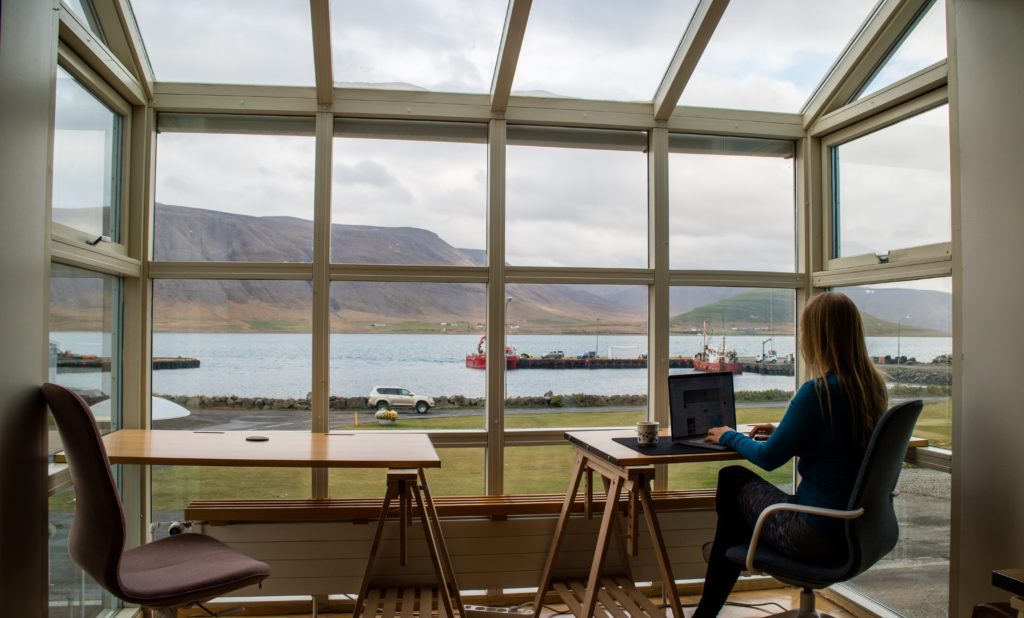
It’s wild to think the majority of us used to go to an office to work.
You remember the days: people would get up, shower, coif their hair, get dressed in work-appropriate attire, fight public transit or rush hour traffic, and, if they drove to work, need to find suitable parking all in an effort to go to work.
Employees had assigned desks. They had a designated office or, more commonly, a cubicle in a communal open office. People shared kitchens, coffee rooms, and bathrooms during the workday.
Not anymore.
Now, people are just as likely to work from home in their comfy clothes. They never have to waste time on a long commute and are already home when the work day ends. The best part: they never have to share the coffee.
What does this mean for the future of work? What will the workplace hold for us beyond 2022?
The answer is complicated—keep reading for 5 key themes that are reshaping the workplace.
Theme 1: Remote work is now a permanent fixture

Remote work is one of the key workplace shifts that resulted from the current COVID era.
Today, people can work from anywhere—and they do. Thanks to the pandemic, we’ve collectively reimagined how and where we work.
One 2022 report calls this new trend the “Everywhere Workplace” and an earlier 2021 study supported this shift as well. Together, these studies found that:
- 87% of people want a hybrid work model.
- Nearly half (45%) said they’d be happy never to have to go to a traditional office again.
- 63% of growing companies have permanently adopted a “work anywhere” model.
- 71% of people would choose remote work over a promotion or a pay raise.
Why?
People said a desire to save money (40%), avoid a commute (48%), have a flexible schedule (43%), and enjoy work-life balance (43%) as the reasons for why they prefer remote work.
The knowledge workforce was expected to return to the office after vaccinations and workplace testing became the norm; they haven’t necessarily. Why not? We’ll discuss this question next.
Why we’re not going back to the office

The past year was tense economically, socially, and politically with volatility that’s expected to continue in 2022; here’s why:
- The risk of new Covid variants persists,
- A war for workforce talent is ongoing,
- Resignation rates remain very high,
- Record-breaking inflation continues to climb,
Because of the economic and social stressors that continue to plague workers, employers have no choice but to stay flexible on the idea of remote work. With advances and adaptations in technology, performance and productivity metrics, and security, they certainly can.
There’s no going back to the traditional office.
The future seems destined to embrace the ‘everywhere workforce’. Employers who don’t embrace it risk losing talent—which brings us to our next workplace theme: employee turnover.
Theme 2: Employee turnover will continue

The Great Resignation began in the spring of 2021 and is expected to continue into the second half of 2022, even in Canada. We liken this to a buyer’s market in real estate—we’re in the midst of an employee market where the jobs are plentiful and the talent is scarce.
The cause of this mass exodus is a change in priorities. Employees have been moved the following higher up their priority lists:
- Wellbeing,
- Physical, emotional, and mental health,
- Families and friends, and
- Recreational pursuits and hobbies.
People have reevaluated their attitudes towards work. In the coming year, companies will have to be flexible and creative if they want to keep their talent. Asking employees to return to the office may only increase turnover rates.
Unfortunately, increased work flexibility won’t be enough to stop employee turnover. Which factors, then, will keep workers happy and engaged for the long-term? Let’s discuss those next.
Factors that will influence employee retention in 2022

The factors will lead to happier, more content, more loyal employees will include:
- Pay increases
- Shorter work weeks
- Flexible schedules
- Remote and hybrid work options—geography will no longer play a role in who is hired
- Meaningful work
- A sense of agency and responsibility for their work
- A strong corporate culture where employees can make strong social ties at work
In 2022, workers are reflecting on the who, how, and why of their work—and moving on to other opportunities if they don’t like what they discover.
Theme 3: New tools and technologies will direct the future of work

New tools will create connection, improve performance, and reduce ‘proximity bias’
As remote work continues, employers and managers will need to contend with:
- How to keep their teams connected, engaged, and productive without giving them the impression their every move is being monitored,
- How to spend more time building relationships with their team members now that they’re scattered around geographically, and
- How to mitigate and reduce in-office vs. remote employee performance bias.
Where that last point is concerned, ‘proximity bias’ is real. A fall 2021 survey revealed that 64% of managers and executives believe in-office employees were better reformers.
Unfortunately, employees who choose to work from home are often from underrepresented groups and risk being further marginalised at work (more on this in a later theme).
What’s an employer to do to ensure their team is treated humanely and fairly? Answer: use technology.
How new technologies will drive the future of work

Tech will drive the future of work—surprise, surprise—through:
- Improved virtual work environments that are more engaging and inclusive,
- Tools to measure and improve worker performance,
- Technology that assess employee work contributions,
- Tech tools that encourage employee interaction and participation, and
- AI integrations in the workplace.
Where AI is concerned, both in-office and remote workspaces will see a shift towards intelligent tech.
From the management of mundane tasks, to human relations tasks, to the control of office work environments, AI will slowly seep into our work lives. Who knows. Before long an AI work robot might be bringing us our morning coffee!
Theme 4: Workplace inequalities will worsen without active intervention

Do you remember in Theme 3 when we mentioned we’d talk more about marginalised workgroups? We’ve arrived at that point.
In the relatively brief time of the work-from-home revolution (as we like to call it), research has shown that managers favour workers who come into the office. In other words, they’re partial to those they can see on a daily basis—an unconscious bias called “proximity bias.”
The result is remote workers are often paid less, promoted less, and overlooked for bigger work assignments compared to their office counterparts.
You might explain away these results by assuming remote workers are less productive—and you’d be wrong. The same studies showed we’re more productive when we work from home.
Who’s harmed by hybrid work models?

Women, people of colour, and other marginalised groups prefer to work from home compared to their white and male counterparts. The reasons for this are often social; lack of child care, lack of reliable or affordable transportation, or caregiving duties often make it easier to work remotely.
The problem with this, if you haven’t already guessed, is that coupled with proximity bias these groups are at even greater risk of the existing and ever broadening wage gap and stifled career growth.
Without employers actively and intentionally working to counteract these biases, talented workers will be overlooked when career opportunities arise.
Theme 5: Smart workplaces and experience design will be the future of work

A discussion about the future of work wouldn’t be complete without mentioning ‘smart’ work. What do we mean by this?
We’ve all heard of smart cars and smart homes. Why not smart offices?
The digital transformation, or digitization, of companies in and beyond 2022 will give birth to the smart office, one that’s conceived, designed, and built on the idea that employees can connect and collaborate whether they’re in the office or working virtually.
Think of the smart workplace as a work metaverse, one with:
- A vibrant physical office that’s more of a co-working space than a traditional office,
- Advanced online working platforms to compliment the physical workplace,
- A cohesive hybrid virtual/live working model that acts as a social hub,
- Augmented reality (!) to help build that sense of cohesion,
- Tech and apps that improve teammate communication, build stronger working relationships, boost creativity, and support employee work and personal lives
Cutting-edge workplace design and the Workplace Experience Manager

To ensure cohesion between in-office, hybrid, and remote teammates, companies will offer:
- Extra-curricular activities for teambuilding—that employees will want to attend!
- Dynamic and fun virtual and in-person office environments people will be excited to go to—and not only the type only Google can afford.
How to businesses’ intend on achieving this big happy work family of workers who may be working in different places? Why, by hiring a Workplace Experience Manager (WEM) to oversee it all, that’s how!
The role of the WEM is one thing: to ensure a sense of togetherness and inclusion for all members of the hybrid workforce of the future.
The future of work: Is creating a ‘new normal’ impossible?

It’s safe to say we’re in the midst of the biggest workplace shift of our generation. Never before has the current workforce experienced so much change in so little time.
Employees were first asked to transition to working at home overnight, then they had to quickly learn and use new forms of technology many had never used before (at least not on an ongoing basis), then adjust again when the world started to open up.
Companies had to quickly decide where they wanted to land post-pandemic; were they going to re-emerge as a 100% virtual team? A hybrid team? One where employees could decide for themselves what type of work environment they wanted? Time will tell.
The future of work in 2022 means change

We’re living in an era where workplaces, the job market, and talent pools are all different from a little over two years ago.
If our 5 themes for the future of work have shown up anything it’s that employers and employees should get comfortable with change. There’s no sign of any new workplace status quo in the future. The sooner we as a workforce accept this, the sooner we can enjoy working in our company’s new virtual/in-person world.
The future of work from anywhere in 2022

Backbone Executive Offices has been ahead of the ‘work-from-anywhere’ curve. We’ve offered our members the chance to work remotely long before COVID.
Our coworking spaces give our members the chance to connect with like-minded entrepreneurs, small business owners, and team members and in an atmosphere that’s inspiring and community-focused.
True, we don’t have an AI coffee robot (yet), but as we’ve seen with the nature of work in the past couple of years, work is changing fast.—it may be only a matter of time until we do.
Until then, we invite you to come for a visit. We promise a membership at Backbone will position you well for the future of work, no matter where it may take us.
Book a tour of Backbone today.
Share this:
Want a tour of the space?
Our community of go-getter entrepreneurs could use another one like you! Shoot us a message if you have any questions or want to book a showing.
Backbone Coworking & Executive Offices
104-32615 S Fraser Way
Abbotsford, BC, V2T 1X8
Phone: 236-233-3200
